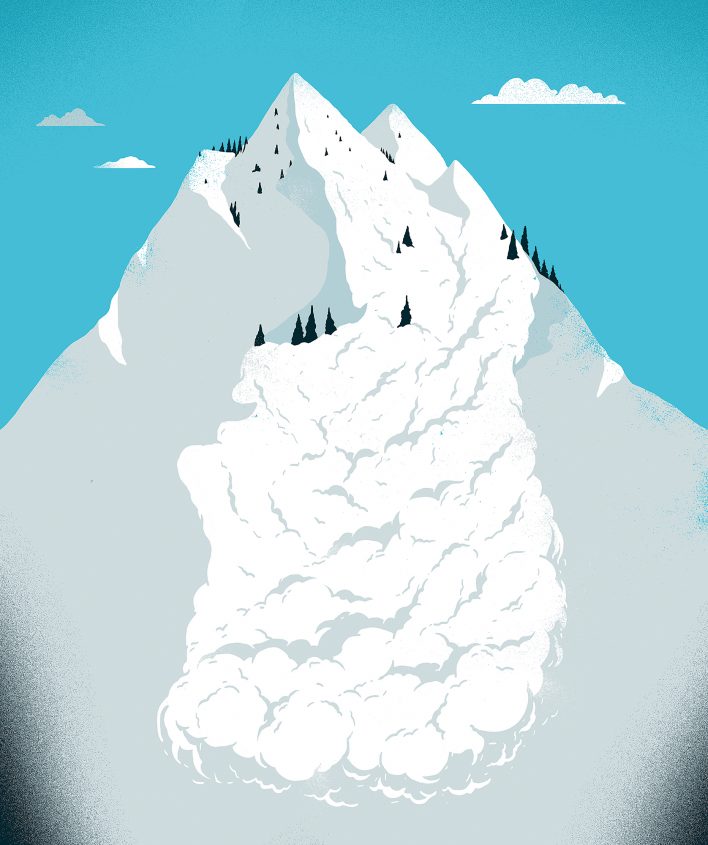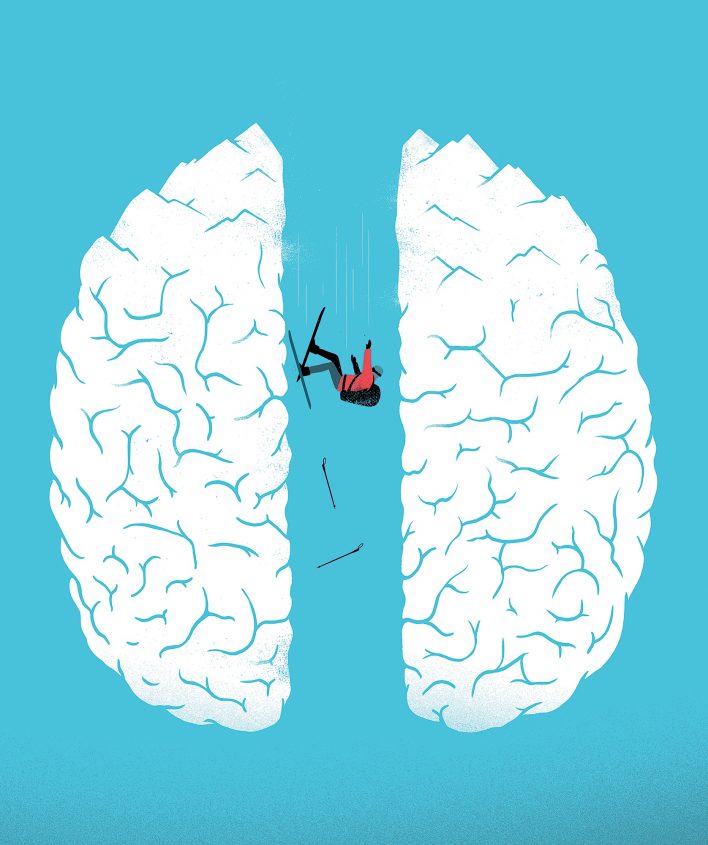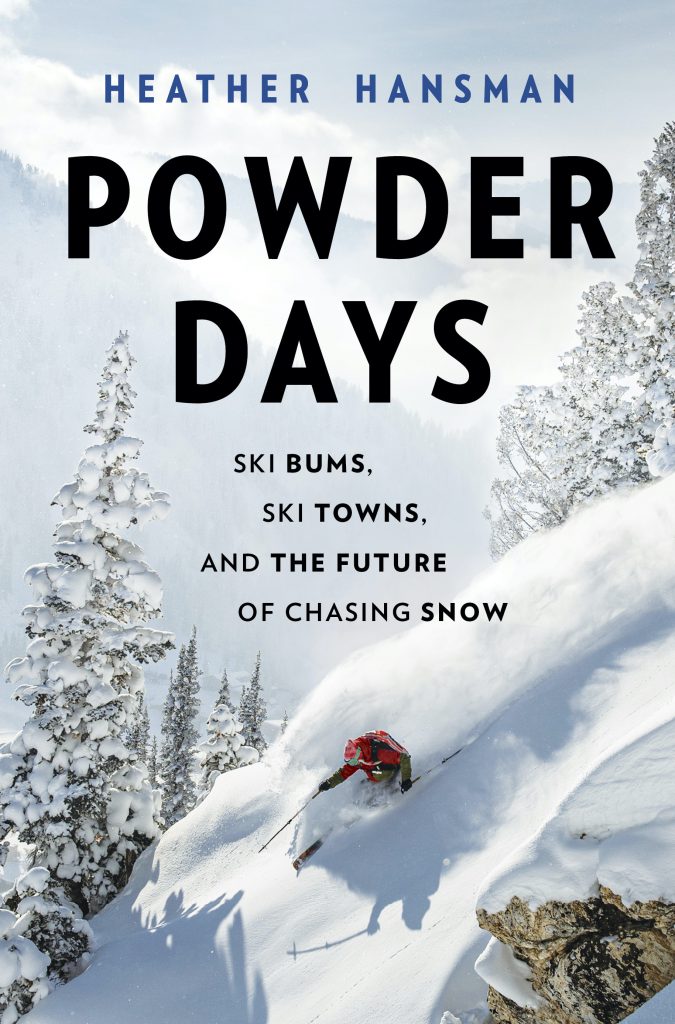Among backcountry users, trauma is rampant—but not just the physical kind. To address and help break social stigmas and to keep rescuers safe, hard-nosed professionals are starting to speak up about the mental trauma that’s ever present in the mountains.

Dave Richards says the image is impossible to shake.
“He was wearing a green jacket,” Richards remembers, “and the first body part we got to was his left hand with a gold wedding band on it.”
It was the winter of 2004/05, in the heart of a class 5 avalanche cycle in Utah’s Wasatch Mountains, the kind of storm cycle that avalanche professionals dream of but hope to never see again. Richards, now the director of Alta Ski Area’s Avalanche Office, dug up four dead bodies in three weeks. The man in the green jacket was the first avalanche fatality Richards saw that season, and he couldn’t get the memory out of his mind.
“I’m going to quote my favorite movie and say that ‘hard mountains make for hard men,’” Richards says. “People go to the mountains, and in the mountains you die, and anyone who thinks different is naïve, but we don’t talk about the after-effects of that.” So Richards coped by shoving the images away, by not talking about the deaths he witnessed, by drinking and making jokes and going out to do his job over again.
A decade and a half later, on stage at last winter’s Utah Snow and Avalanche Workshop, Richards opened up in front of 600 professional rescuers about the lasting trauma he’s incurred from a career in the mountains. He talked about how the layered-on accidents stuck with him and took their toll, resulting in hypervigilance, anxiety and eventually a breakdown that led to hospitalization. And he figured he’d be rejected and shunned for not being tough enough to handle the stress that came with the territory or that his peers would think they couldn’t depend on him in an emergency.
“When I stood up in front of the avy workshop, I thought I would end my career,” he says. Stepping on that stage, he says, and sharing the places where he felt vulnerable and weak was scarier than jumping off a cliff. But his fear turned out to be unfounded.
DREW HARDESTY, A 20-YEAR FORECASTER at the Utah Avalanche Center, has spoken and written about risk and post-traumatic stress disorder (PTSD). And he believes that, when addressing mental health in the mountains, both the message and messenger were crucial—the topic needed to be discussed, and because of the macho mountain culture, the message needed to come from inside the house. “To me it almost seems like all these things have been coming together across the spectrum of public safety in the last few years,” Hardesty says. “But Dave kicked the door open in terms of the winter avalanche world.”
Richards finished his presentation to a standing ovation and cracked open a crucial conversation about how we talk about and deal with trauma in the backcountry, where risk is a constant part of the picture and both professional and recreational skiers often roll the dice. But in the face of the death, injury and the resulting distress, a culture of emotional hardness doesn’t hold benefits in the long run.
Richards isn’t the only one dealing with the impacts of mental trauma—the outpouring of gratitude after his talk underscored that for him and for others. But very few people have traditionally been publically open about the aftermath of trauma, and the gratitude that Richards received proves the value of opening the conversation. Still, there’s much to be done to normalize discussion around mental trauma, to keep pace with a rapidly changing winter sports industry.
“Something really interesting happened in the ski industry—there has been a massive shift in acceptable risk,” says Jake Hutchinson, an avalanche educator and former head of ski patrol and avalanche safety at Utah’s Canyons Resort. “Ski equipment accelerated the learning curve. That’s great, but the thing people [don’t] get is experience. I see this in the backcountry so much now. You go from the bunny hill to [the] top of the mountain. Then you take speed and gravity and endorphins and adrenaline, and there’s a huge potential for bad things to happen.”
Hutchinson knows first-hand how bad those outcomes can be, having once been responsible for opening an inbounds area that slid, resulting in a fatality. He says he bottled up the guilt and shame he felt surrounding the incident, which led to years of self-harm ranging from risky backcountry decision-making to drinking too much. When he finally addressed the trauma and started going to therapy and talking about his experiences, he saw how much it had been impacting his life.
Although these people speaking out are professionals, risk and consequences don’t just apply to avalanche workers. Realistically, the more time you spend in the mountains, even if you make good decisions, the higher the likelihood of experiencing something bad or being part of a scarring incident. There’s an old adage that there are old climbers and bold climbers but no old, bold climbers. “Stay in the mountains long enough,” Hardesty adds, “and shit is going to happen.” What’s less predetermined is how you might deal with an accident and whether you build resiliency ahead of time and afterward.

THE NATIONAL INSTITURE OF HEALTH (NIH) defines a traumatic event as a shocking, scary or dangerous experience that affects someone emotionally and physically. Such an event in the mountains can look like anything from watching a partner get seriously injured to helping with a body recovery, and the effects that occur in the wake of such situations can manifest themselves in varying ways over short or long periods of time. Experiencing trauma impacts everyone differently, and Richards says one person may not be fazed by an incident while a similar event may cause long-term effects in another. Such effects range from anxiousness and trouble concentrating to PTSD, the clinically diagnosed mental health condition with far-reaching consequences, from exhaustion and feelings of detachment to depression and self-destructive behavior.
Like many of the inputs and impacts of high-risk activities, it can be hard to tell where one begins and another ends, or where something like stoicism goes from being helpful to being toxic. Richards says, for instance, that vigilance is a crucial part of being aware and safe in avalanche terrain, while on-edge hypervigilance can be brutal and unsustainable.
And because it can be difficult to determine when a stressful situation tips over into one that causes long-lasting trauma, it can be hard to talk about tough incidents, where peers may seem to be coping in different ways. But that stress can fester, and the common tools for addressing emotional trauma, like talking about it, taking breaks and seeking professional help, can be perceived as a sign of weakness in a culture where toughness is currency.
Richards is now open about his mental health struggles, but it took him a long time to get there. He admits he only opened up because he hit the bottom of darkness, and he had a good support system, including a supervisor who told him to get help.
“Up until this year I only had one person ask me if I was OK. I never talked about it because being mentally ill in mountain communities is very difficult,” he says. “Pervasive in mountain communities and mountain cultures is this ‘buck up, Chuck’ attitude. It’s this idea that everyone else seems OK, and I’m the wierdo who can’t handle it.”
But seeming unbreakable creates a false paradigm that suggests everyone is fine and unwavering in the face of carnage. “People in my community are very good caretakers in the heat of the moment, not very good in the long run,” Richards acknowledges. “It’s easy when you can see the physical trauma, but mental is hard.”
Laura McGladrey, a mental health nurse practitioner who focuses on stress injuries in the mountains, says that it’s also hard to bring in the idea that you don’t have to be tough all the time in a culture that, often for good reason, prizes toughness. Or to bring up the dichotomy that people who are strong, capable and respond well to emergencies and who can suffer through big days in the mountains can also hurt, have long-standing damage and be vulnerable.

“We need to be honest with the cost of doing this stuff for years and years,” Hutchinson says. “There’s a lot of better ways of dealing with it besides going to the bar until you can’t stand up.” The problem with skiing or backcountry rescue, he feels, is that, unlike in fire or police forces that are also talking about PTSD, there’s no overarching snow- or backcountry-specific organization that is currently acknowledging these issues on a national level.
Even so, different groups, from avalanche educators to search and rescue teams and nonprofit mental-health organizations, are trying to address the stress and risk that come from working and recreating in the mountains in an effort to break the stigma around speaking up and asking for help. McGladrey, for example, is working with some individual groups, like Yosemite Search and Rescue, Colorado’s Eldora Ski Patrol and Oregon’s Portland Mountain Rescue, to develop post-incident protocol and patterns for talking more frequently about mental trauma.
One way to get in front of it is to talk about potential bad outcomes ahead of time and to be very concrete about what the risks are. “We used to ask people, post-mortem ski tour, what they did right and wrong, and now we’re asking, ‘Where were we most vulnerable?’” Hutchinson says. “You’re always vulnerable, sometimes you can’t avoid it, but we’re getting people thinking about it.”
Richards says it’s important to talk realistically about consequences, including giving beginner backcountry skiers graphic warnings about what it’s like to excavate a body that’s just been swept through an avalanche path full of trees at 200 miles per hour. Especially as the mountains get more crowded, he notes that it’s crucial for people to know that they, or those around them, are making decisions with potentially disastrous consequences.
In that vein, Hardesty emphasizes the need to talk about pre-traumatic stress, to prepare ahead of time for how to react to hard situations and to consider the kind of care that’s available to seek out, so people don’t come home crushed after a scarring experience. “If we can train ourselves beforehand, we can treat ourselves after,” he says. “It’s a baseline for conversations.”
And then, McGladrey says, if and when something bad does happen, it’s crucial for those involved to have someone they trust to talk to and to break the stigma associated with not being OK, so they can process an incidents and get the right kind of help.
Reverend Dr. Scott K. Beebe, pastor of Colorado’s Mount of the Holy Cross Lutheran Church and a member of Vail Mountain Rescue Group, says the hardest part of treating trauma is being open to conversations about loss and grief and then starting those conversation. “In the face of trauma people tend to pull inward, especially on a rescue team, because they tend to be Type A people who are passionate and want to help and not be vulnerable,” he says. “A lot of times you’re not ready for the trauma, and seeing people hurting or suffering can be a real traumatic experience. It creates all kinds of turmoil inside. Where we get into trouble is where we bottle it up. When it’s pushed down long enough, it’s going to come out somehow.”
Beebe says he has an advantage in addressing such topics because he’s both trained in counseling and is a member of a rescue team, a combination that’s hard to find and builds a level of trust and understanding that comes from recognizing what goes into a rescue. Hardesty says it’s also why Richards’s message has resonated. He believes that people in niche, hard-man and exclusive communities don’t want a “soft” doctor or scientist telling them it’s all right to cry or crumble, but when it’s someone like Richards, who has been through the same experiences, they can hear and relate to it.
As more voices like Beebe’s and Hutchinson’s rise to the forefront of the conversation, and proud, tough, people are willing to be vulnerable about their pain and internal struggles, mountain culture slowly becomes more open and ultimately, hopefully, safer. “It trickles down more than it trickles up. If an older guy can say, ‘It hurts,’ that will trickle down,” Richards says. In his roles at the top of a patrol and as a trusted voice from the trenches, he has the capacity to push for social and institutional change.
Both are necessary. Richards says that last winter was hard in Utah’s mountains; they saw a lot of fatalities, and their crew was dispatched to incidents and body recoveries. Now, however, they’re starting to discuss a situation before they head out, to debrief it after and to then keep checking in.
“The thing that made this year different is that we’re talking about it. Now we look at each other and say, ‘Are you OK?’” Richards says. “This year, in the midst of countless hours with my employees digging up bodies and recovering dead people, it’s suddenly OK to say, ‘I’m not.’”

Heather Hansman is the author of Powder Days: Ski Bums, Ski Towns, and the Future of Chasing Snow, which comes out in November 2021. It looks at the myth of living the dirtbag dream, if it’s sustainable and why it’s not always as dreamy as it sounds. Hansman, who only occasionally lives in a vehicle these days, is still trying to answer these questions for herself.
This piece was originally published in February 2019 in Issue #133. To read more, pick up your copy at BackcountryMagazine.com/133 or subscribe.










Post traumatic stress syndrome (no, I would not term it a disorder) is common.
Are you a doctor of medicine, Harold Maio, or just giving an armchair opinion?
Pastor Scott, I have often thot of you & rescuers and the stress that goes w/ that position. I’m proud to say I know you and all you do on this mission. Blessings & hope you can help others but don’t forget or neglect to get the support you need also! Thank you for sharing the real pkg.